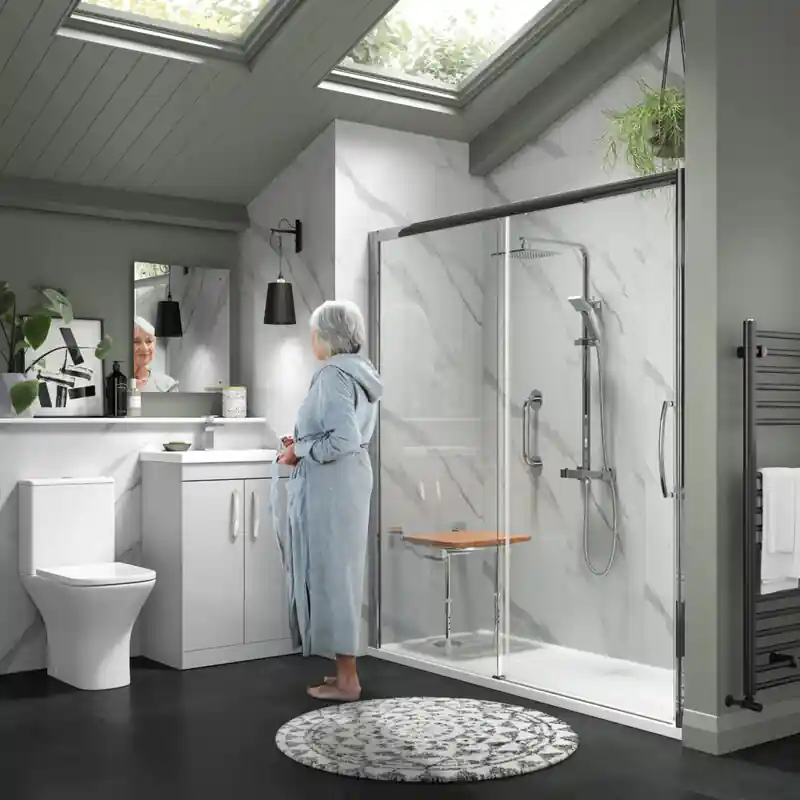Creating Accessible Bathrooms for Elderly Loved Ones

When elderly parents or grandparents visit your home, the bathroom can become a source of anxiety rather than comfort. Slippery surfaces, high step-ins, and awkward positioning can transform a simple daily routine into a challenging obstacle course. Whether you’re accommodating visiting relatives or future-proofing your own home, making thoughtful bathroom modifications ensures everyone feels safe and independent.
The good news? You don’t need a complete renovation to make meaningful improvements. Small changes can dramatically enhance bathroom safety and accessibility, giving your loved ones the confidence they deserve.
Why Bathroom Safety Matters for Elderly Users
Falls in the bathroom account for a significant portion of home accidents among older adults. Wet surfaces, confined spaces, and the need to move between sitting and standing positions create multiple risk factors. Beyond preventing injuries, accessible bathroom features preserve dignity and independence – qualities that matter deeply to those navigating age-related mobility changes.
Creating an accessible bathroom benefits everyone in your household. Features designed for elderly users often enhance comfort and usability for people of all ages.
Essential Bathroom Modifications for Enhanced Safety
Walk In Showers for Elderly Users
Traditional shower cubicles with high thresholds pose genuine challenges for elderly users. A walk in shower for elderly family members eliminates the need to step over barriers, reducing fall risks considerably. Look for designs with:
- Level-access entries or minimal thresholds (no more than 15mm)
- Non-slip flooring throughout
- Built-in seating or fold-down shower seats
- Handheld shower heads with adjustable brackets
If a complete shower replacement isn’t feasible, consider adding a shower seat and grab rails to your existing setup.
Walk In Baths for Ultimate Comfort
For elderly family members who prefer baths but struggle with mobility, walk in baths for elderly users offer an ideal solution. These specially designed tubs feature:
- Watertight doors that open inward or outward
- Built-in seating at comfortable heights
- Non-slip surfaces
- Easy-reach controls
- Optional therapeutic features like jets or heated surfaces
Walk in baths maintain the relaxing bath experience whilst dramatically improving safety and accessibility.
Strategic Grab Rail Placement
Properly positioned grab rails provide crucial support during bathroom activities. Install them:
- Next to the toilet (both sides if space permits)
- Inside shower areas (horizontal and vertical options)
- Near the bath entry and exit points
- Along walls where users transition between standing and sitting
Choose rails that contrast with your wall colour to improve visibility, and ensure they’re rated for appropriate weight limits.
Non-Slip Solutions That Actually Work
Bathroom floors become treacherous when wet. Effective non-slip solutions include:
- Textured ceramic or vinyl flooring
- High-quality bath mats with sucker backing
- Non-slip strips for existing smooth surfaces
- Absorbent bathroom rugs positioned strategically near exits
Replace worn bath mats regularly, as their effectiveness decreases over time.
Raised Toilet Seats and Support
Standard toilet heights can be problematic for elderly users with joint issues or limited mobility. Consider:
- Raised toilet seats that add 2-4 inches of height
- Toilet frames with armrests for additional support
- Wall-mounted grab rails positioned beside the toilet
- Toilet paper holders within easy reach
These modifications make sitting down and standing up significantly easier and safer.
Additional Comfort Features
Improved Lighting
Good visibility prevents accidents and increases confidence. Install:
- Motion-activated night lights for safe navigation
- Bright overhead lighting without harsh shadows
- Light switches positioned at accessible heights
- Illuminated mirrors for better task lighting
Accessible Storage
Keep essentials within easy reach by:
- Installing shelving at appropriate heights
- Using shower caddies that don’t require bending
- Positioning towel rails near seating areas
- Ensuring toiletries are easily accessible
Temperature Control
Prevent scalding and maintain comfort with:
- Thermostatic shower valves
- Easy-to-operate taps with lever handles
- Clear hot/cold indicators
- Comfortable water pressure settings
Planning Your Bathroom Modifications
Start by observing how elderly family members currently use your bathroom. Notice where they hesitate, what they struggle with, or areas they avoid. This insight guides your improvement priorities.
Consider consulting with occupational therapists or mobility specialists who can assess specific needs and recommend appropriate solutions. Many modifications qualify for grants or assistance programs, particularly if they’re for permanent residents.
Budget considerations vary widely, but prioritise high-impact, safety-critical improvements first. A well-placed grab rail and non-slip mat can prevent serious injuries whilst you plan larger modifications.
Making Your Home Truly Welcoming
Creating an accessible bathroom demonstrates thoughtfulness and care for elderly family members. These modifications ensure that visiting parents or grandparents can maintain their independence and dignity during stays at your home.
Whether you’re planning for occasional visits or preparing for long-term care situations, bathroom accessibility improvements represent a wise investment in safety and comfort. Start with one or two key modifications and expand your improvements over time.
Your elderly family members will appreciate the consideration, and you’ll have peace of mind knowing you’ve created a safer environment for everyone who uses your home.



Leave a reply